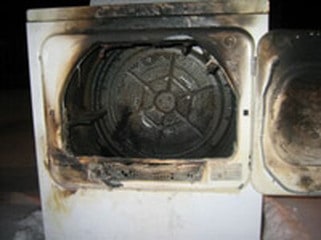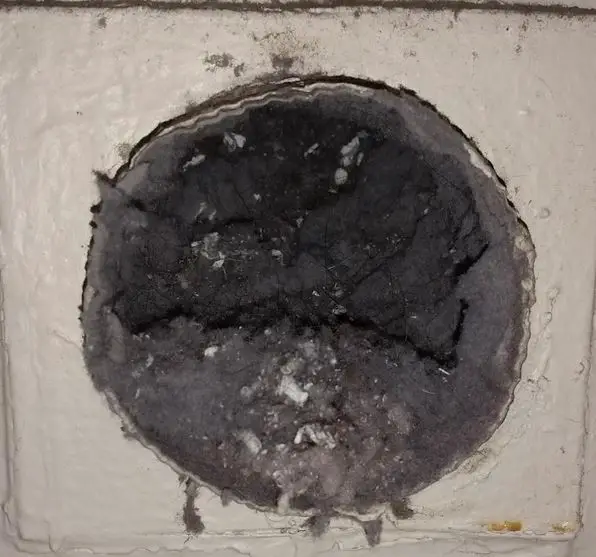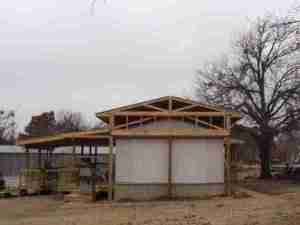Dryer safety is an issue in mobile homes mostly because the dryer exhaust vent is often left under the home and forgotten about. Out of sight, out of mind. However, your mobile home dryer vent should never empty out under your home.
“An ounce of prevention is worth a pound of cure.” -Benjamin Franklin
When we hear the words preventive maintenance we often think about big jobs such as replacing roofs, installing more efficient windows, and adding new siding. Of course, those are all great ways to create a healthy home but preventive maintenance also entails the smaller more tedious jobs too. One of those jobs is mobile home dryer safety and maintenance.
There are a lot of advantages to preventive maintenance for your appliances. They last longer, your home stays safer, and you save money. Proper maintenance also minimizes the inconvenience of downtime and repair costs. Also, the cost of dryer vent cleaning is not as much in the long run as the one you’ll spend when the damage is already noticeable.
Mobile Home Dryer Safety 101: Where to Position Your Hose
Your dryer is one of the most dangerous appliances in your home. Failure to maintain it is one of the leading causes of fires in all homes, not just mobile homes. However, mobile homes can be more susceptible to dryer issues if the vent is left under the home and hidden by mobile home’s skirting. This is usually because we don’t see the end of the dryer vent as we walk around the home and can’t tell just how much lent the vent has collected.
If at all possible, all mobile home owners should extend the dryer hose so that it ends at the skirting. You can cut a hole our the size of the vent hose and cover it with screening (not too tight but not too closed up either – a 1/2″ is probably fine). This will allow heat and lent to exit outside of the home and not under it.
Here are some sobering facts about dryers from the NFPA’s U.S. Home Product Report: Appliances and Equipment Involved in Fires, January 2002 found on Carthage Fire Department’s website:
- There were 14,300 clothes dryer fires in U.S. homes in 1998, resulting in 19 deaths, 312 injuries and $67.7 million in direct property damage.
- The leading cause of home clothes dryer fires was lack of maintenance (30%), followed by unidentified or unknown-type mechanical failure (11%) and part failure, leak or break (10%).
- Clothing (not on a person) was the most common source of ignition in home clothes dryer fires, followed by dust, fiber or lint.

See images of poorly installed dryer vents here.
The lack of maintenance is one of the leading causes of dryer fires. Blocked air flow causes the dryer to perform poorly by raising the operating temperature and causing overheating.
Dryers are also one of the most expensive appliances to run in a home. Being proactive and maintaining your dryer well you can save a ton of money!
Cleaning a Dryer
Cleaning a dryer’s lint trap isn’t the only step in dryer maintenance. Your dryer vent needs to be cleaned every few months too.
Take a look at a dryer vent that hasn’t been cleaned in a while:

In the image above, proper airflow is completely closed off and the lint buildup has stopped all airflow. This will make the dryer overheat quickly and can cause a fire. It is so important to take a few minutes to make sure your vent doesn’t look like this – it must be lint-free and able to create a proper air flow.
Cleaning Your Dryer and Vent
For each and every load of clothes, you dry you should clean the lint trap well. The dryer manufacturer will determine where the lint trap will be – ours is on top of the dryer but I’ve had a dryer that had the lint trap inside the door before.
Every few months you should take a few extra minutes to vacuum around the lint trap, behind the dryer, and the vent attached to the dryer to remove lint buildup. if you can remove the top of your dryer easily, go ahead and remove it and vacuum around the inside as well.Take apart and clean your dryer with a vacuum every one to three years depending on usage.
Use a vacuum cleaner and a long brush to clean behind the lint trap and any other accessible areas such as behind the dryer on a regular basis.
Clean the dryer vent and exhaust duct periodically. Check the outside vent while the dryer is operating to make sure exhaust air is escaping. If it is not, the vent or the exhaust duct may be restricted or blocked. If you find you have a blockage in your exhaust duct it will be necessary to disassemble and clean the ductwork. If your not sure exactly how to do this you should contact a professional service technician to properly do the procedure.
Dryer Safety Precautions
Proper cleaning of your dryer is essential to help prevent accidental fires in your home, however, there are more options to help you reduce the chance of a dryer related fire. Here are some dryer safety precautions you should consider:
- Make sure your dryer air exhaust line is not restricted.
Check periodically that the vent is not crushed, bent or dented as this will restrict airflow. Make sure that the dryer is plugged into an outlet suitable for its electrical needs. Overloaded electrical outlets can result in blown fuses or tripped circuit breakers. All dryers should be installed by a professional.
- Have your gas-powered dryer inspected by a professional occasionally to ensure that the gas lines and connections are to code and leak free.
- Don’t overload your dryer. It will take longer to dry the clothes and the dryer will wear out quicker.
- Never use a dryer without a lint trap. You should be able to order a new one through your dryer manufacturer or the store you purchased the dryer from.
More Dryer Safety Tips
Cleaning your dryer regularly and adhering to the dryer safety tips above is a great way to ensure a long-lasting and safe dryer. Here are a few other suggestions for a safe and reliable dryer:
- Replace plastic or foil accordion-type ducting material with a rigid or corrugated semi-rigid metal duct. They do cost more but they are much better at keeping their shape and are easier to clean out with a brush and vacuum.
- Cleaning your lint trap once a month with dawn dish soap helps reduce the film build-up caused by using dryer sheets. The invisible film restricts airflow causing your dryer to work harder and cost you money (double check with your manufacturer before doing this).
- Turn the dryer off when leaving the home, if it malfunctions no one will be there to prevent a possible disaster.
- An average load of clothes has about one-half gallon of water. If your washer has an extra or extended spin cycle consider using it – this can help reduce your dry time. It often costs more to run your dryer than your washer.
- Consider installing a dryer safety monitor. Gardus makes a product called the LintGard that monitors the back-pressure of your dryer vent.
Taking a few steps to ensure your appliances are as safe as possible can keep a disaster away!
Read the DIY Networks 7 page checklist for a trouble-free home.
Thank you for reading Mobile Home Living!
Image Sources: Imgur.com, Alpine Specialty Cleaning






